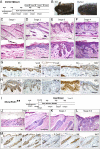Wounding enhances epidermal tumorigenesis by recruiting hair follicle keratinocytes
- PMID: 21321199
- PMCID: PMC3054016
- DOI: 10.1073/pnas.1014489108
Wounding enhances epidermal tumorigenesis by recruiting hair follicle keratinocytes
Erratum in
- Proc Natl Acad Sci U S A. 2012 Apr 3;109(14):5548. Svärd, Jessica [added]; Teglund, Stephan [added]
Abstract
Chronic wounds and acute trauma constitute well-established risk factors for development of epithelial-derived skin tumors, although the underlying mechanisms are largely unknown. Basal cell carcinomas (BCCs) are the most common skin cancers displaying a number of features reminiscent of hair follicle (HF)-derived cells and are dependent on deregulated Hedgehog (Hh)/GLI signaling. Here we show, in a mouse model conditionally expressing GLI1 and in a model with homozygous inactivation of Ptch1, mimicking the situation in human BCCs, that the wound environment accelerates the initiation frequency and growth of BCC-like lesions. Lineage tracing reveals that both oncogene activation and wounding induce emigration of keratinocytes residing in the lower bulge and the nonpermanent part of the HFs toward the interfollicular epidermis (IFE). However, only oncogene activation in combination with a wound environment enables the participation of such cells in the initiation of BCC-like lesions at the HF openings and in the IFE. We conclude that, in addition to the direct enhancement of BCC growth, the tumor-promoting effect of the wound environment is due to recruitment of tumor-initiating cells originating from the neighboring HFs, establishing a link between epidermal wounds and skin cancer risk.
Conflict of interest statement
The authors declare no conflict of interest.
Figures





Comment in
-
Tumorigenesis: Wound-up tumours.Nat Rev Cancer. 2011 Apr;11(4):235. doi: 10.1038/nrc3043. Nat Rev Cancer. 2011. PMID: 21548398 No abstract available.
References
-
- Jaks V, Kasper M, Toftgård R. The hair follicle—a stem cell zoo. Exp Cell Res. 2010;316:1422–1428. - PubMed
-
- Morris RJ, et al. Capturing and profiling adult hair follicle stem cells. Nat Biotechnol. 2004;22:411–417. - PubMed
-
- Snippert HJ, et al. Lgr6 marks stem cells in the hair follicle that generate all cell lineages of the skin. Science. 2010;327:1385–1389. - PubMed
-
- Jaks V, et al. Lgr5 marks cycling, yet long-lived, hair follicle stem cells. Nat Genet. 2008;40:1291–1299. - PubMed
Publication types
MeSH terms
LinkOut - more resources
Full Text Sources
Other Literature Sources
Medical
Molecular Biology Databases
Research Materials
Miscellaneous

